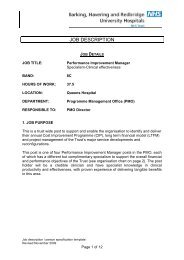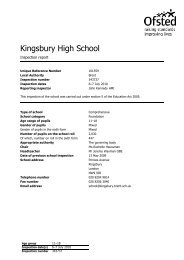ICT Strategy 2013 - Hays
ICT Strategy 2013 - Hays
ICT Strategy 2013 - Hays
You also want an ePaper? Increase the reach of your titles
YUMPU automatically turns print PDFs into web optimized ePapers that Google loves.
Business <strong>ICT</strong> <strong>Strategy</strong><br />
<strong>2013</strong>-2016<br />
Version 1.0<br />
April <strong>2013</strong>
CONTENTS<br />
1 INTRODUCTION ............................................................................................................................... 3<br />
1.1 Business <strong>ICT</strong> <strong>Strategy</strong> <strong>2013</strong>-2016 ............................................................................................ 3<br />
1.2 <strong>ICT</strong> Vision ................................................................................................................................. 3<br />
1.3 Objectives of the Business IT <strong>Strategy</strong> <strong>2013</strong>-2016 .................................................................. 4<br />
1.4 <strong>ICT</strong> Services in South Gloucestershire Council ........................................................................ 4<br />
1.5 Corporate <strong>ICT</strong> Services ............................................................................................................ 6<br />
2 ON THE ROAD TO 2016: RECENT AND EMERGING BUSINESS AND <strong>ICT</strong> TRENDS............................. 7<br />
2.1 The role of <strong>ICT</strong> in supporting the Council’s Vision and Core Values ....................................... 7<br />
2.2 Economic environment ........................................................................................................... 8<br />
2.3 Technology enablers for the Business <strong>ICT</strong> <strong>Strategy</strong> ................................................................ 8<br />
2.4 Environmental Sustainability ................................................................................................ 10<br />
2.5 UK Government <strong>ICT</strong> Standards and Guidance ...................................................................... 10<br />
2.6 Aligning with the Council’s core values ................................................................................ 11<br />
2.7 <strong>ICT</strong> strategic themes ............................................................................................................. 12<br />
2.8 Delivering the Council’s priorities ......................................................................................... 13<br />
2.9 Optimising <strong>ICT</strong> service delivery ............................................................................................. 14<br />
3 AN ENTERPRISE ARCHITECTURE BASED APPROACH ..................................................................... 15<br />
3.1 Architectural Principles ......................................................................................................... 16<br />
3.2 Developing the Business <strong>ICT</strong> <strong>Strategy</strong> ................................................................................... 18<br />
3.3 Recommended strategic project portfolio............................................................................ 20<br />
4 LEADERSHIP AND GOVERNANCE .................................................................................................. 23<br />
4.1 Strategic alignment ............................................................................................................... 23<br />
4.2 <strong>ICT</strong> Target Operating Model (TOM) ...................................................................................... 23<br />
4.3 <strong>ICT</strong> skills and staff development ........................................................................................... 23<br />
4.4 Service management framework .......................................................................................... 24<br />
4.5 Information and security management ................................................................................ 25<br />
4.6 Vendor management ............................................................................................................ 25<br />
4.7 Business <strong>ICT</strong> <strong>Strategy</strong> governance ........................................................................................ 26<br />
4.8 Transparent cost of technology services .............................................................................. 27<br />
5 STRATEGY INTO ACTION <strong>2013</strong>-2014 ............................................................................................. 28<br />
6 SUMMARY AND CONCLUSION ...................................................................................................... 30<br />
South Gloucestershire Council Business <strong>ICT</strong> <strong>Strategy</strong> <strong>2013</strong>-2016 Page 2 of 30
1<br />
1.1 Business <strong>ICT</strong> <strong>Strategy</strong> <strong>2013</strong>-2016<br />
South Gloucestershire Council’s vision is to achieve the best for our residents and their communities,<br />
ensuring that South Gloucestershire will always be “a great place to live and work”.<br />
Information and Communications Technologies (<strong>ICT</strong>) has a critical and expanding role in enabling the<br />
Council’s ambition, by providing both radically different ways for customers to access and use<br />
services, and encouraging new internal working practices which can improve both service quality<br />
and staff productivity whilst reducing the overall operating costs of the Council.<br />
The purpose of this document is to define the South Gloucestershire Council <strong>ICT</strong> <strong>Strategy</strong> for the<br />
years 2012 to 2016. It builds upon work already undertaken and the key principles of how <strong>ICT</strong> can be<br />
used to effectively support the delivery of the Corporate Plan objectives. The <strong>ICT</strong> <strong>Strategy</strong> sets out a<br />
fresh approach to the provision of corporate <strong>ICT</strong> services within the Council (excluding the provision<br />
of <strong>ICT</strong> Services for Schools).<br />
This strategy is intended to be flexible so that <strong>ICT</strong> developments are not constrained by it but can<br />
change in line with advances in technology and changes in Council priorities, whilst still having a<br />
clear framework within which to operate. It aims to provide a framework for the delivery of<br />
innovative services to our customers, to build a reliable and resilient business driven technical<br />
infrastructure which is both cost-effective and sustainable, and to keep environmental costs to a<br />
minimum.<br />
An organisation-wide project was established to define this strategy. Its board had senior<br />
representation across all departments and a programme of workshops and analysis ensured <strong>ICT</strong><br />
users were appropriately consulted.<br />
1.2 <strong>ICT</strong> Vision<br />
“To provide trusted, agile, innovative and robust value-for-money <strong>ICT</strong> solutions that<br />
enable the organisation to be effective and productive – putting the customer at the<br />
heart of all we do.”<br />
South Gloucestershire Council Business <strong>ICT</strong> <strong>Strategy</strong> <strong>2013</strong>-2016 Page 3 of 30
1.3 Objectives of the Business IT <strong>Strategy</strong> <strong>2013</strong>-2016<br />
1. Define and agree how <strong>ICT</strong> will be used effectively and efficiently as an enabler in the delivery<br />
of the Council’s business objectives<br />
2. Define a business system and technical architecture and a measurable roadmap to deliver<br />
common use corporate and service specific capabilities<br />
3. Set out a target operating model to deliver effective and efficient operational services to<br />
agreed service levels<br />
4. Define how IT innovation and agility will maximise associated benefits<br />
5. Define an <strong>ICT</strong> governance model to enable the strategy to be applied and implemented<br />
6. Enable and deliver a step change in <strong>ICT</strong> culture across both the service departments and the<br />
<strong>ICT</strong> function<br />
7. Underpin the Business <strong>ICT</strong> <strong>Strategy</strong>, with a rolling 4 year portfolio of business enabling <strong>ICT</strong><br />
change projects<br />
1.4 <strong>ICT</strong> Services in South Gloucestershire Council<br />
1.4.1 About the Council<br />
South Gloucestershire Council is a unitary Council with above average performance and high levels<br />
of resident satisfaction. It is an organisation that performs in the top quartile of Councils with<br />
funding in the bottom quartile.<br />
South Gloucestershire has a rich natural and cultural heritage. It is a mixed urban and rural authority<br />
of great diversity located in the South West of England. It covers 53,665 hectares.<br />
The district has a population of 264,800 and this is projected to increase by 20% to 308,100 by 2026.<br />
60% of the population live in built areas, 19% in markets towns and the remaining 20% live in the<br />
rural areas. This provides an interesting dynamic given 80% of the geographical area is rural and only<br />
20% urban.<br />
South Gloucestershire is relatively affluent but there are pockets of deprivation. The district has seen<br />
substantial levels of development with 62,000 jobs and 21,000 homes since 1991.<br />
Like all local authorities, South Gloucestershire is facing intense financial pressures. Funding from<br />
government will reduce by at least six per cent each year to 2017/18, with similar sums possible for<br />
a number of years after this.<br />
South Gloucestershire Council Business <strong>ICT</strong> <strong>Strategy</strong> <strong>2013</strong>-2016 Page 4 of 30
1.4.2 Provision of Council Services<br />
The dispersed nature of the Council’s communities means that service delivery can be costly and<br />
complex which places additional pressure on the Council to strike a balance between competing<br />
customer demands and to be clear about priorities.<br />
The Council provides many of the key public services required to meet the needs and expectations of<br />
the growing population. The Council educates over 58,000 children and young people in 114 schools<br />
as well as caring for 170 children and young people who are looked after. The Council helps more<br />
than 4,850 older people and those with disabilities to continue living in their own homes.<br />
This is in addition to protecting the rich environment and diverse communities whilst ensuring that<br />
the aspirations of the residents for quality jobs and homes are met. From children’s services to<br />
community care, from planning the development of the Council’s infrastructures to strengthening<br />
the prevention and reduction of crime, from waste collection to environmental protection, South<br />
Gloucestershire Council provides over 150 public services which are vital to the residents of the area.<br />
Excluding schools, 3,100 staff members are engaged in providing these services. Additionally an<br />
increasing proportion of our services are being provided by external partners.<br />
In order to make South Gloucestershire ‘a great place to live and work’ the core values of South<br />
Gloucestershire Council, as detailed in the Council <strong>Strategy</strong> 2012/16 are:<br />
Excellence for our customers and communities;<br />
Strong Community Leadership;<br />
Valuing our Staff;<br />
Engaging with our partners;<br />
Equality of opportunity for all;<br />
Protecting the Environment for future generations; and<br />
Using our resources to deliver Value for Money.<br />
South Gloucestershire Council Business <strong>ICT</strong> <strong>Strategy</strong> <strong>2013</strong>-2016 Page 5 of 30
1.5 Corporate <strong>ICT</strong> Services<br />
The shape of the Council’s corporate <strong>ICT</strong> service is undergoing a transformation that commenced in<br />
late 2011 as a response to the changing business requirements of the Council, changes to the way<br />
services need to be delivered to the community and on-going cost pressures.<br />
Over the last few years there has been increasing emphasis on flexibility and agility in the way the<br />
Council delivers services and <strong>ICT</strong> have put in place a number of supporting initiatives; in particular<br />
the Smarter Working initiative launched in 2009 which has seen a shift of 20%-30% of staff now<br />
working remotely on a regular basis. This service development work is on-going and <strong>ICT</strong> is<br />
committed to continuing to develop new and innovative ways to meet the requirements of the<br />
business and support it in delivering the Council’s core values as set out above.<br />
The corporate <strong>ICT</strong> function supports the 3,100 staff engaged in providing services and there are<br />
currently approximately 4,000 desktops, laptops, thin client or tablet devices. There are around 30<br />
key business systems and almost 600 business productivity applications in regular use. There are<br />
three primary IT locations and around 30 branch and satellite offices.<br />
In addition, the Schools IT service provides <strong>ICT</strong> support services to 114 schools in the Council area<br />
and makes use of the corporate IT Data Centres and Network services. The Business <strong>ICT</strong> <strong>Strategy</strong><br />
<strong>2013</strong>-2016 anticipates increasing co-operation between Corporate <strong>ICT</strong> and Schools IT services with a<br />
joint approach to <strong>ICT</strong> service provision whenever appropriate.<br />
The major restructure of the provision of corporate <strong>ICT</strong> services was delivered as part of the<br />
Council’s wider transformation programme. The overriding aim of the new <strong>ICT</strong> organisational<br />
structure is to maximise customer service and work more effectively to manage and deliver IT<br />
enabled business change. The service will continue to provide professional IT advice and technical<br />
support to all areas of the organisation including Councillors, other Council departments and<br />
partners.<br />
The Business <strong>ICT</strong> <strong>Strategy</strong> will shape and drive the on-going <strong>ICT</strong> transformation journey over the<br />
coming period of <strong>2013</strong>-2016 and will build on the established foundations to meet the new and<br />
emerging business requirements.<br />
South Gloucestershire Council Business <strong>ICT</strong> <strong>Strategy</strong> <strong>2013</strong>-2016 Page 6 of 30
2<br />
In developing the Business <strong>ICT</strong> <strong>Strategy</strong> <strong>2013</strong>-2016 a number of enabling or underpinning factors<br />
were considered as follows:<br />
The current and emerging trends within the <strong>ICT</strong> industry and how these have been<br />
successfully adopted in other businesses;<br />
The role that the <strong>ICT</strong> service has to play in supporting and enabling the Council’s stated<br />
vision and core values;<br />
The impact of the current economic landscape;<br />
The requirements for environmental sustainability; and<br />
Current and emerging <strong>ICT</strong> standards and guidance from central government.<br />
2.1 The role of <strong>ICT</strong> in supporting the Council’s Vision and Core Values<br />
Localism, regional partnership and policy development, the emergence of city mayors, Police Crime<br />
Commissioners, changes to the National Health Service and other national and regional<br />
developments demand closer working with our neighbouring Councils, other public sector bodies,<br />
the voluntary sector and national government.<br />
The wider Council <strong>Strategy</strong> <strong>2013</strong>-2016 emphasises our ethos of one Council with “..everyone<br />
working in an integrated way..” and our “..culture of collaborative working”.<br />
This need for ever closer collaboration places demands on the Business <strong>ICT</strong> <strong>Strategy</strong> to provide the<br />
right systems and services to support and deliver this vision.<br />
The period <strong>2013</strong>-2016 will see the Council face continuing challenges such as:<br />
The continued reshaping of the organisation;<br />
Further reductions in available budget for services;<br />
Increased pressure for efficiencies and productivity gains; and<br />
Greater requirement for mobility in delivering front line services.<br />
In this more collaborative, distributed environment, understanding the link between Council policy<br />
and investment decisions and outcomes for customers will become even more important. The<br />
Council will require strong <strong>ICT</strong> Governance processes to shape the investment decisions going<br />
South Gloucestershire Council Business <strong>ICT</strong> <strong>Strategy</strong> <strong>2013</strong>-2016 Page 7 of 30
forward, maximise the return and value for money, and support the organisation in meeting its<br />
objectives. To achieve these goals the Council will require a step change in culture moving to an<br />
approach where an organisation-wide view is always applied to <strong>ICT</strong> decision making.<br />
The Council will also require strong information management processes and systems including<br />
collaboration tools, social media tools, and greater integration and interoperability across the <strong>ICT</strong><br />
landscape, to support not just management reporting but the overall goal of ever more integrated<br />
working.<br />
2.2 Economic environment<br />
The forecasted economic environment over the period <strong>2013</strong>-2016 is expected to place further<br />
pressures on budgets, back office services and central service overheads.<br />
The Business <strong>ICT</strong> <strong>Strategy</strong> <strong>2013</strong>-2016 will drive the more efficient use of IT assets through the use of<br />
the Total Cost of Ownership model, ensuring that the <strong>ICT</strong> cost base demonstrates good value for<br />
money whilst delivering high quality services. This approach calculates the end-to-end whole life<br />
costs of IT Services – from procuring an application, through to data storage, desktop operating<br />
system, network access, maintenance and support, security, and the decommissioning and disposal<br />
of IT assets.<br />
This will require increased rigour in the assessment of change requests for <strong>ICT</strong> investments and the<br />
implementation of formal governance around the delivery of the Business <strong>ICT</strong> <strong>Strategy</strong>.<br />
2.3 Technology enablers for the Business <strong>ICT</strong> <strong>Strategy</strong><br />
A number of enabling factors will support the delivery of the Business <strong>ICT</strong> <strong>Strategy</strong>:<br />
The cost of access devices (PCs, laptops, tablets etc.), connectivity circuits and “data centre” services<br />
have fallen significantly in recent years, with some business applications migrating to ‘cloud based’<br />
delivery accessible from anywhere via the Web. Suppliers, local government and national<br />
government are all investing heavily in cloud computing models and the Business <strong>ICT</strong> <strong>Strategy</strong> will<br />
seek to leverage these service models for the Council wherever possible to deliver Value for Money<br />
over the period of <strong>2013</strong>-2016 while ensuring our information security obligations continue to be<br />
met.<br />
Over the last two decades, the Internet has developed as a major channel for exchanging<br />
information between citizens and government, both local and central. In recent years the further<br />
computerisation of government processes has enabled wider opportunities for self-service and the<br />
introduction of greater automation. The Business <strong>ICT</strong> <strong>Strategy</strong> will leverage the further automation<br />
of Council business processes, greater business systems integration, and channel shift.<br />
South Gloucestershire Council Business <strong>ICT</strong> <strong>Strategy</strong> <strong>2013</strong>-2016 Page 8 of 30
Consumerisation of <strong>ICT</strong>, or “Bring Your Own Device” (BYOD) or “Bring Your Own Computer (BYOC), is<br />
rapidly becoming the norm within the wider business community, and is based on a simple premise:<br />
employees can bring their own devices to work and access all the business systems they need to<br />
carry out their day job. The rationale being that this option increases staff satisfaction as they have<br />
self-selected a device that they find easy and enjoyable to use, and allows the <strong>ICT</strong> function to focus<br />
on other strategic initiatives, rather than managing and troubleshooting a large estate of physical<br />
devices. There is already a demand within the Council from staff to allow them to use their own<br />
devices for work purposes. The Business <strong>ICT</strong> <strong>Strategy</strong> <strong>2013</strong>-2016 will therefore support this<br />
aspiration and establish the environment that enables this to happen in a secure manner.<br />
As virtualisation technologies mature there are increasing opportunities to do more with limited<br />
resources. In turn, employee expectations are rising. They are looking for greater mobility, device<br />
flexibility and solutions from corporate <strong>ICT</strong> that can help them in their daily jobs. The Business <strong>ICT</strong><br />
<strong>Strategy</strong> will leverage virtualisation technologies to deliver solutions that support growth, are costeffective,<br />
and make <strong>ICT</strong> solutions more efficient, flexible and productive.<br />
Application consolidation may hold even more savings potential than server virtualisation for the<br />
council. Application consolidation can merge redundant systems into a common platform that<br />
reduces complexity, saves money on software licensing and enhances information sharing.<br />
Consideration for application consolidation has been incorporated throughout the development of<br />
the council’s Business <strong>ICT</strong> <strong>Strategy</strong> and will form a core aspect of the ongoing <strong>ICT</strong> governance.<br />
In delivering the Business <strong>ICT</strong> <strong>Strategy</strong> the Council will:<br />
Continue to review the functionality and opportunities of emerging cloud offerings;<br />
Assess ‘fitness for purpose’ of proposed solutions when assessing business<br />
requirements;<br />
Ensure that solutions are as ‘future proof’ as possible;<br />
Ensure that agreed SLAs and recovery times are developed, agreed and communicated;<br />
Demonstrate the value for money that solutions offer the Council.<br />
Through the Business <strong>ICT</strong> <strong>Strategy</strong> the Council will seek further economies of scale through supplier<br />
rationalisation and consolidation, whilst delivering more business focused IT services which meet the<br />
needs of our services and customers. The Business <strong>ICT</strong> <strong>Strategy</strong> will support the rationalisation of the<br />
Council office accommodation, providing increased flexibility for home working including use of<br />
personal devices for Council business and enhance our business continuity provisions where<br />
required.<br />
South Gloucestershire Council Business <strong>ICT</strong> <strong>Strategy</strong> <strong>2013</strong>-2016 Page 9 of 30
2.4 Environmental Sustainability<br />
It is essential that the Council’s <strong>ICT</strong> services are delivered in a way that minimises environmental<br />
impact and contributes to the Council’s environmental delivery targets and aspirations. Importance<br />
is particularly placed on:<br />
Careful procurement which minimises the <strong>ICT</strong> estate, thus reducing energy use in<br />
manufacture, operational use, and end of life disposal;<br />
Reducing energy use of the <strong>ICT</strong> desktop estate, supporting the Carbon Management<br />
Plan, and reducing electricity costs to the organisation;<br />
Reducing energy use and heat generated by <strong>ICT</strong> servers, supporting the Carbon<br />
Management Plan and reducing electricity costs to the organisation;<br />
Encouraging the re-use of <strong>ICT</strong> assets that can benefit the wider community and<br />
contribute to the digital inclusion initiative, and where this is not possible, to carefully<br />
commission end of life waste disposal for all <strong>ICT</strong> equipment including consumables so<br />
that there is no detrimental environmental impact and minimising waste to landfill.<br />
Reductions in the carbon footprint will be sought from 2012/<strong>2013</strong> including <strong>ICT</strong> estate<br />
consolidation/rationalisation, increased use of thin client devices and a rationalisation of <strong>ICT</strong> data<br />
centres.<br />
2.5 UK Government <strong>ICT</strong> Standards and Guidance<br />
The UK Government has developed an <strong>ICT</strong> <strong>Strategy</strong> underpinned by a range of standards, guidance<br />
and services. In particular, the Public Services Network (PSN) is at the foundation of the Government<br />
<strong>ICT</strong> <strong>Strategy</strong>. PSN provides an assured network over which Government can safely share services,<br />
including many GCloud services; collaborate in new ways, and work more effectively and efficiently<br />
than ever before.<br />
In developing the Business <strong>ICT</strong> <strong>Strategy</strong> we have taken cognisance of the extensive work already<br />
done by the Cabinet Office around <strong>ICT</strong> strategy and services and will seek to leverage these services<br />
to deliver efficiencies in the delivery of Council services over the period of <strong>2013</strong>-2016.<br />
South Gloucestershire Council Business <strong>ICT</strong> <strong>Strategy</strong> <strong>2013</strong>-2016 Page 10 of 30
2.6 Aligning with the Council’s core values<br />
The Business <strong>ICT</strong> <strong>Strategy</strong> <strong>2013</strong>-2016 has been developed to provide the capabilities required to<br />
support the Council’s vision and core values as set out in the Council <strong>Strategy</strong> <strong>2013</strong>-2016. During the<br />
development of the Business <strong>ICT</strong> <strong>Strategy</strong> a number of Strategic Themes for <strong>ICT</strong> were developed by<br />
the Business and <strong>ICT</strong> to support these core Council values and the diagram below illustrates their<br />
mutual alignment.<br />
Delivering Value<br />
for Money `<br />
Working in an<br />
integrated way<br />
Protecting the<br />
environment<br />
Flexible<br />
Infrastructure<br />
Engaging with<br />
our partners<br />
Customer<br />
focused<br />
Collaborative<br />
working<br />
Excellence for our<br />
customers and<br />
communities<br />
Adaptable and<br />
appropriate skilled<br />
workforce<br />
Figure 1 - Alignment of <strong>ICT</strong> Strategic Themes and Core Council Values<br />
South Gloucestershire Council Business <strong>ICT</strong> <strong>Strategy</strong> <strong>2013</strong>-2016 Page 11 of 30
2.7 <strong>ICT</strong> strategic themes<br />
Theme<br />
Information<br />
management<br />
Efficiency and<br />
effectiveness<br />
Collaboration<br />
Customer<br />
service<br />
External<br />
partnerships<br />
Protecting the<br />
environment<br />
Description<br />
The Business <strong>ICT</strong> <strong>Strategy</strong> recognises the need to drive up customer satisfaction<br />
through consistent, common standards and effective front-line activities, whilst<br />
also reducing corporate overheads on services. Through this theme, focus will be<br />
given to customer records in departmental systems which underpin almost all<br />
Council service delivery. Improved governance and tools will be developed, and<br />
further use made of document and records management to provide an evidence<br />
base for Council decision-making.<br />
The <strong>ICT</strong> Transformation programme which commenced in 2011 highlighted a<br />
proliferation of technologies, systems and applications across the various<br />
directorates that appear to carry out similar and/or overlapping functions.<br />
Through this theme, focus will be given to consolidating the various systems in use<br />
and rationalise the technologies deployed across the Council.<br />
The theme of collaboration is one that resonates with the wider Council <strong>Strategy</strong><br />
<strong>2013</strong>-2016 and is a key element to the Council’s vision and core values. The<br />
technologies to support collaboration across the Council will be addressed as part<br />
of the Workplace Environment opportunity (Table 4 – High priority strategic<br />
Infrastructure recommendations) which also supports the environmental theme<br />
by looking at the greater use of conferencing technology for meetings to reduce<br />
staff travel.<br />
The theme of customer service is one that is particularly emphasised in the wider<br />
Council <strong>Strategy</strong> <strong>2013</strong>-2016 and is also a key element to the Council’s vision and<br />
core values. All the opportunities set out in the strategy must consider whether<br />
they enhance customer service as part of assessing the potential benefits.<br />
However, the Appointments Booking opportunity (Table 5 – High priority<br />
strategic organisation-wide recommendations) was identified as offering<br />
particular benefits with regard to customer service.<br />
The theme of improving our interaction with external partners is another key<br />
element of the wider Council <strong>Strategy</strong> <strong>2013</strong>-2016. The technologies to support<br />
interactions with external partners will be considered in all <strong>ICT</strong> initiatives and in<br />
particular development of standard extranet technologies, collaboration spaces<br />
and processes.<br />
The theme of protecting the environment is one of particular importance to the<br />
Council and will be considered when formulating the delivery of <strong>ICT</strong> projects. The<br />
Workplace Environment and Single Integrated Network opportunities (Table 4 –<br />
High priority strategic Infrastructure recommendations) both have the potential to<br />
deliver a cost effective and energy efficient <strong>ICT</strong> estate that delivers reduced<br />
environmental impact and enables new and sustainable ways of working for the<br />
Council.<br />
Table 1 - <strong>ICT</strong> Strategic Themes<br />
South Gloucestershire Council Business <strong>ICT</strong> <strong>Strategy</strong> <strong>2013</strong>-2016 Page 12 of 30
2.8 Delivering the Council’s priorities<br />
The Business <strong>ICT</strong> <strong>Strategy</strong> will encourage the convergence, wherever possible, of business<br />
applications onto more corporately aligned collaboration platforms moving away from traditional<br />
departmental ‘silo’ applications that will not deliver the collaboration or value for money necessary<br />
to tackle the service provision challenges facing the Council and its customers.<br />
The Council will retain on a case by case basis “best of breed” systems that deliver unique<br />
requirements of individual Council services. This strategic approach will support increased joint<br />
working that leverages, wherever possible, common systems and services on a shared services basis<br />
– both within and external to the organisation.<br />
The Business <strong>ICT</strong> <strong>Strategy</strong> will require more sharing of systems and functionality across Council<br />
departments to deliver the common business processes wherever required and an approach that<br />
seeks to adapt individual department’s business processes on a best practice basis to enable use of<br />
these common systems rather than adapting systems to meet individual business processes.<br />
Critical to the Council in the period <strong>2013</strong>-2016 will be the unlocking of the aggregated value of<br />
information captured and managed in departmental systems through the implementation of a<br />
standardised approach to data interfacing and interoperability between departmental systems,<br />
whilst ensuring we continue to comply with all relevant information governance requirements.<br />
The Business <strong>ICT</strong> <strong>Strategy</strong> will seek to leverage more flexible and customer-driven solutions where<br />
possible incorporating Web and social networking tools to track and improve customer satisfaction<br />
levels.<br />
Underpinning the Business <strong>ICT</strong> <strong>Strategy</strong> will be a set of agreed Service Level Agreements and<br />
business recovery timescales for key systems, to ensure that the organisation can depend on robust,<br />
available and reliable <strong>ICT</strong> services.<br />
South Gloucestershire Council Business <strong>ICT</strong> <strong>Strategy</strong> <strong>2013</strong>-2016 Page 13 of 30
2.9 Optimising <strong>ICT</strong> service delivery<br />
The delivery of the Business <strong>ICT</strong> <strong>Strategy</strong> will reflect the priorities of the Council and the way our<br />
services are delivered. “Commodity” or utility services, such as document management systems,<br />
network services and data centre services, will be procured through outcome-based contracts using<br />
an aggregated approach where appropriate (i.e. we will be vendor neutral and seek the most<br />
economically advantageous contracts for delivering these technologies, simplifying and<br />
standardising commodity or utility applications and services across the Council where possible).<br />
Through the Business <strong>ICT</strong> <strong>Strategy</strong> we will improve our contract and procurement arrangements for<br />
those maintenance and support services essential to underpinning the delivery of <strong>ICT</strong> services. This<br />
will require the development of enhanced supplier management, commercial and contract<br />
management skill sets to deliver value for money and customer satisfaction.<br />
The Council will seek to develop relationships with key technology partners to support requirements<br />
for rapid deployment of significant business change initiatives or to provide additional 3 rd line<br />
support capacity in key infrastructure technology areas.<br />
The Council will also seek to further rationalise the <strong>ICT</strong> supplier base and drive greater supplier<br />
aggregation to drive out savings whilst ensuring business needs are still appropriately met.<br />
South Gloucestershire Council Business <strong>ICT</strong> <strong>Strategy</strong> <strong>2013</strong>-2016 Page 14 of 30
3<br />
The Council has adopted an Enterprise Architecture as the basis for achieving Business/<strong>ICT</strong> alignment<br />
within the Business <strong>ICT</strong> <strong>Strategy</strong>. It is based upon the industry best practice framework TOGAF (The<br />
Open Group Architecture Framework).<br />
“Enterprise architecture is the organizing logic for business processes and IT infrastructure reflecting<br />
the integration and standardization requirements of the company's operating model. The operating<br />
model is the desired state of business process integration and business process standardization for<br />
delivering services to customers. Enterprise Architecture models are arranged in a logical manner<br />
that provide an ever-increasing level of detail about the enterprise: its objectives and goals; its<br />
processes and organization; its systems and data; the technology used and any other relevant<br />
spheres of interest.”<br />
During 2012 an Enterprise Architecture was developed to provide a technical, contractual and<br />
commercial framework for future Council <strong>ICT</strong> service provision decisions. The absence of a<br />
framework in the past has caused <strong>ICT</strong> and the wider Council to react to technology requests with adhoc<br />
or interim solutions.<br />
The Enterprise Architecture sets out a common strategic approach which offers significant cost and<br />
service benefits. This approach will help to ensure that the Council provisions only what is needed,<br />
that provisioned services will operate effectively together with increasing interoperability, and that<br />
the Council can continue to further rationalise and optimise the <strong>ICT</strong> estate and improve the<br />
performance and effectiveness of <strong>ICT</strong> operations across the organisation. These principles have been<br />
developed using both industry and government standards and guidance and adapted to our Council<br />
needs.<br />
Going forward business and technology requirements will be assessed against a set of agreed<br />
Architecture Principles and only those requirements and solutions that meet these principles will<br />
progress to detailed business case development and approval.<br />
South Gloucestershire Council Business <strong>ICT</strong> <strong>Strategy</strong> <strong>2013</strong>-2016 Page 15 of 30
3.1 Architectural Principles<br />
The following set of Architectural Principles, which will govern the design and provisioning of the<br />
Council’s <strong>ICT</strong> services, are summarised in the following table. There is no set priority contained<br />
within these principles with the relative priority of each considered on a case by case basis.<br />
Ref Architecture Principle Explanation<br />
1 Generic capabilities in<br />
systems where possible,<br />
versus bespoke systems<br />
2 Control technical diversity<br />
and consolidate<br />
The Council will pursue a strategy of configuring fit-for-purpose<br />
packaged software rather than bespoke software development,<br />
and wherever possible encourage the use of “vanilla” products<br />
with minimal local customisation.<br />
The Council will seek to minimise and standardise the portfolio<br />
of technology implemented across the business. We will seek to<br />
consolidate technology so that multiple solutions share core<br />
infrastructure appropriately. We will capitalise on<br />
organisational-wide licensing benefits and remove multiple<br />
versions of the same software whenever possible. We will also<br />
seek to ensure that all projects embed decommissioning<br />
activities as part of project deliverables and cost.<br />
3 Prioritise supportability The Council will procure and implement solutions that inherently<br />
consider the whole life support skills and resources required so<br />
that service delivery can be maintained and ensure projects<br />
embed IT and business staff training as part of project<br />
deliverables and cost. We will ensure that projects consider the<br />
on-going support requirements as part of their decision making<br />
processes, and ensure the resources to deliver these are<br />
identified.<br />
4 Design common use<br />
solutions that promote<br />
reuse of business<br />
functionality<br />
5 Maximise existing and<br />
future <strong>ICT</strong> investment<br />
6 Embed appropriate<br />
Disaster Recovery and<br />
Business Continuity<br />
provision<br />
7 Ensure availability of <strong>ICT</strong><br />
Services<br />
The Council will seek to provide generic <strong>ICT</strong> capabilities available<br />
to the whole organisation that can be repurposed to deliver<br />
specific solutions for individual service areas. Where<br />
appropriate we will also enable the reuse of standard business<br />
process and functionality.<br />
<strong>ICT</strong> provisioning decisions will control cost of ownership and<br />
support business needs whilst balancing cost, functionality, risk<br />
and benefits. This includes reuse of existing applications,<br />
infrastructure and skills/capabilities within the business and with<br />
our partners. This principle will not impose unacceptable<br />
limitations on transformation, and the enterprise architecture<br />
will govern the introduction of technology according to actual<br />
business need.<br />
Solutions and infrastructure will be selected, configured and<br />
deployed in such a way that the business is protected from<br />
individual component failures according to prioritised risk and<br />
impact assessments. We will ensure appropriate contingencies<br />
and reduce risk for when serious failures occur.<br />
Solutions and infrastructure will be designed to meet the<br />
required levels of availability of the business. This may include<br />
special provision at key times to support periodic fluctuations in<br />
demand for the service area.<br />
South Gloucestershire Council Business <strong>ICT</strong> <strong>Strategy</strong> <strong>2013</strong>-2016 Page 16 of 30
8 Ensure value for money Through effective contract management and appropriate<br />
selection of solutions and suppliers, <strong>ICT</strong> and the business will<br />
prioritise value for money by considering total cost of ownership.<br />
9 Enable agility in <strong>ICT</strong><br />
Services<br />
<strong>ICT</strong> systems and services will be designed to ensure agility and<br />
flexibility to support potential and known future requirements<br />
based on business planning and forecasting. This includes<br />
consideration of factors such as simplicity and cost of change<br />
without complex dependencies on additional <strong>ICT</strong> resource or<br />
equipment.<br />
10 Ensure scalability <strong>ICT</strong> systems and services will be designed to ensure scalability to<br />
support potential and future use based on business planning and<br />
forecasting. This includes consideration of factors such as user<br />
concurrency and data storage capacity.<br />
11 Maximise interoperability<br />
across <strong>ICT</strong> systems<br />
The design of <strong>ICT</strong> systems and services will consider the ease of<br />
data exchange, and system-to-system communication.<br />
12 Focus on robust<br />
information management<br />
and security<br />
Our information will be protected from unauthorised use and<br />
disclosure according to corporate policies and standards. Access<br />
and changes to data will be recorded where appropriate. <strong>ICT</strong><br />
systems, services and processes will be designed in a way to<br />
comply with relevant security policies and industry standards.<br />
13 Compliance with the law <strong>ICT</strong> systems, services and processes will be designed to comply<br />
with relevant legislation and regulation.<br />
14 Ensure data is accessible<br />
and manage master data<br />
15 Maintain effective <strong>ICT</strong><br />
supplier relationships<br />
16 Enable effective<br />
partnership working<br />
17 Provide easy to use<br />
systems<br />
18 Ensure environmental<br />
sustainability<br />
<strong>ICT</strong> systems and services will have appropriate and controlled<br />
access to data. Key data types will be defined consistently<br />
throughout the organisation wherever possible and appropriate.<br />
Data definitions will be understandable to all users. Solutions<br />
should ideally expose data in open formats to encourage and<br />
simplify the analysis, exchange and use of data.<br />
We will aim to foster “partnership” relationships with <strong>ICT</strong><br />
suppliers whilst ensuring quality of service and value for money.<br />
We will implement solutions and processes that enable other<br />
agencies including neighbouring authorities and other public<br />
sector organisations to work efficiently with the Council.<br />
<strong>ICT</strong> systems will be designed and implemented with the needs of<br />
the user in mind so <strong>ICT</strong> systems are intuitive, meet usability and<br />
accessibility best practice.<br />
<strong>ICT</strong> systems will minimise their environmental impact and<br />
consider low energy demands and the further reduction of our<br />
carbon footprint. Through procurement work to ensure our<br />
suppliers are adequately considering their own environmental<br />
responsibilities.<br />
Table 2 - Architectural Principles<br />
South Gloucestershire Council Business <strong>ICT</strong> <strong>Strategy</strong> <strong>2013</strong>-2016 Page 17 of 30
3.2 Developing the Business <strong>ICT</strong> <strong>Strategy</strong><br />
The Business <strong>ICT</strong> <strong>Strategy</strong> <strong>2013</strong>-2016 is supported by a comprehensive component based<br />
assessment of 164 distinct Council business systems and the underlying enabling <strong>ICT</strong> infrastructure.<br />
The component assessment provides the Council with insight into current capabilities and required<br />
future capabilities and defines in some detail the business requirements and needs of the<br />
organisation over the period <strong>2013</strong>-2016. The assessment followed a structured repeatable approach<br />
that allows for additional assessments in the future of capabilities as business requirements develop.<br />
In addition to the component analysis a Council wide “Voice of the Customer” survey of staff was<br />
conducted to seek staff views on current <strong>ICT</strong> service provision.<br />
The component assessment was conducted by the business and <strong>ICT</strong> between August and October<br />
2012. Each component was assessed against the Architectural Principles identified in Section 3.1<br />
above, taking into consideration on-going projects, risks, issues and business challenges, and given<br />
an overall RAG (Red, Amber or Green) rating.<br />
The component assessment ratings were analysed against the Enterprise Architecture and a “Heat<br />
Map” of current capabilities was compiled. The analysis was captured and analysed at a number of<br />
levels of detail with level 1 presenting the highest level of aggregation of current capabilities.<br />
The capability heat map supports the development of a portfolio of opportunities across the<br />
following dimensions:<br />
1. Corporate or departmental i.e. opportunities that will deliver business benefit to individual<br />
departments or functions;<br />
2. Organisation-wide i.e. opportunities that will deliver benefits across the whole Council; and<br />
3. Infrastructure i.e. enabling projects that will underpin the delivery of either service specific<br />
or Council wide capabilities.<br />
Opportunities within the portfolio have been categorised as either Strategic or Tactical/Operational:<br />
Strategic opportunities are defined as capabilities requiring significant attention and may<br />
require the development or delivery of a new system or significant effort to address issues<br />
with an existing set of capabilities. As a result Strategic opportunities may not have preexisting<br />
funding in some cases, or the business case may be more complex or need to<br />
consider a longer time period when looking at whole life costs.<br />
Tactical/Operational opportunities are defined as capabilities requiring a minor upgrade to<br />
an existing system or requiring business as usual support activities, and where funding for<br />
such initiatives is from existing business budgets.<br />
South Gloucestershire Council Business <strong>ICT</strong> <strong>Strategy</strong> <strong>2013</strong>-2016 Page 18 of 30
The following table quantifies projects by category. Please Note: The numbers in ( ) show which of<br />
the total in each group are already underway.<br />
Strategic<br />
Tactical / Operational<br />
Project / Business priority High Medium Low High Medium Low<br />
Infrastructure 5 1 - 6 (3) 3 2<br />
Organisation-wide 9 (3) 7 9 (1) - - -<br />
Corporate and departmental 6 (1) 5 2 20 (9) 4 1<br />
Table 3 - Categorised Projects<br />
In addition details of IT projects already underway with allocated funding were captured; this was to<br />
ensure that when planning the Business <strong>ICT</strong> <strong>Strategy</strong> delivery programme that a complete picture of<br />
already committed resource was understood.<br />
All opportunities, Strategic, Tactical and Operational have been assigned an initial priority of High,<br />
Medium or Low by the Business and <strong>ICT</strong>. The prioritisation was used to guide the development of a<br />
set of delivery recommendations focused initially on the high priority Strategic opportunities only.<br />
The full portfolio of strategic, tactical and operational potential projects is not final and can be<br />
adjusted through the proposed Business <strong>ICT</strong> <strong>Strategy</strong> governance process as business needs and<br />
priorities evolve.<br />
The prioritisation of projects will serve to guide the creation of outline business cases (OBC) and full<br />
business cases to support individual initiatives. The Council will develop OBCs for each candidate<br />
opportunity and assess both the financial and non-financial benefits. The OBCs must be approved<br />
through the Business <strong>ICT</strong> <strong>Strategy</strong> governance process before any opportunity can be taken forward<br />
and form part of an approved portfolio of projects.<br />
South Gloucestershire Council Business <strong>ICT</strong> <strong>Strategy</strong> <strong>2013</strong>-2016 Page 19 of 30
3.3 Recommended strategic project portfolio<br />
The tables in this section list all the strategic opportunities defined by the business. The scope of<br />
the strategic recommendations is limited to the opportunities that were deemed to have a high<br />
business priority.<br />
High level cost estimates have been provided as a precursor to the development of outline business<br />
cases, and where necessary full business cases. This information is supported by an indicative<br />
programme plan. A full explanation of the project scope and benefits is also provided. Potential<br />
projects marked * are already planned as part of the Council’s Transformation and Efficiency<br />
programme.<br />
3.3.1 Infrastructure opportunities<br />
Six strategic projects in total were identified in the Infrastructure category. These are the high<br />
priority recommendations.<br />
Project Primary theme Status Recommendation<br />
High business priority<br />
Workspace<br />
Includes: Desktop, laptop, mobile devices. Shift<br />
to thin-client. Enable ‘bring your own device’.<br />
Operating system and Office suite and Email<br />
upgrade. Unstructured data access and<br />
management.<br />
Efficiency and<br />
effectiveness<br />
Potential Deliver in <strong>2013</strong>-<br />
2014<br />
Identity and access management<br />
Includes: Common repository for security and<br />
identity information. Enabling technology for<br />
greater self-service and portals, mobile data<br />
services, single authoritative phonebook service,<br />
integration to HR data.<br />
Strategic Network Provision<br />
Includes: Consolidating all current networks.<br />
Removing single points of failure. Enabling<br />
prioritisation of types of traffic to ensure quality<br />
of service. Improving options for disaster<br />
recovery services. Unified communications.<br />
Strategic supplier sourcing<br />
Includes: Optimise the current portfolio of over<br />
1000 external suppliers.<br />
Data loss prevention<br />
Includes: Review and improvement of data<br />
backup, data security and disaster recovery<br />
technology.<br />
Information<br />
management<br />
Efficiency and<br />
effectiveness<br />
Efficiency and<br />
effectiveness<br />
Information<br />
management<br />
Potential<br />
Proceed to<br />
business case for<br />
delivery project<br />
Potential Deliver in <strong>2013</strong>-<br />
2014<br />
Potential<br />
Potential<br />
Table 4 – High priority strategic Infrastructure recommendations<br />
Proceed to<br />
business case for<br />
delivery project<br />
Proceed to<br />
business case for<br />
delivery project<br />
South Gloucestershire Council Business <strong>ICT</strong> <strong>Strategy</strong> <strong>2013</strong>-2016 Page 20 of 30
3.3.2 Organisation-wide opportunities<br />
Twenty five strategic projects in total were identified in the Organisation-wide category. These are<br />
the high priority recommendations.<br />
Project Primary theme Status Recommendation<br />
High business priority<br />
Intranet and enterprise search<br />
Includes: Modern intranet and<br />
collaborative working platform. Unified<br />
search of pages, unstructured data and<br />
people information<br />
Collaboration Potential Proceed to<br />
business case for<br />
delivery project<br />
Enterprise GIS<br />
Includes: Rationalisation of GIS<br />
technology. Enable enhanced mapping<br />
and spatial services to staff and the<br />
public.<br />
Document and records management *<br />
Includes: Review existing process and<br />
provision for document management<br />
and scanning across the organisation.<br />
Consider technology consolidation.<br />
Implement robust records<br />
management.<br />
Performance management *<br />
Includes: Review processes and need<br />
for specific technology.<br />
Data interoperability and integration<br />
Includes: Developing standards,<br />
processes and technologies, enabling<br />
effective integration.<br />
Appointment booking *<br />
Includes: Implement technology for<br />
enabling self-service and mediated<br />
appointment booking services.<br />
Efficiency and<br />
effectiveness<br />
Information<br />
management<br />
Efficiency and<br />
effectiveness<br />
Information<br />
management<br />
Potential Deliver in <strong>2013</strong>-<br />
2014<br />
Potential<br />
Potential<br />
Potential<br />
Proceed to<br />
analysis based on<br />
T+E programme,<br />
business case as<br />
initial output<br />
Proceed to<br />
analysis based on<br />
T+E programme,<br />
business case as<br />
initial output<br />
Proceed to<br />
business case for<br />
delivery project<br />
Customer service Potential Proceed to<br />
delivery based on<br />
T+E and Customer<br />
First programme<br />
Table 5 – High priority strategic organisation-wide recommendations<br />
South Gloucestershire Council Business <strong>ICT</strong> <strong>Strategy</strong> <strong>2013</strong>-2016 Page 21 of 30
3.3.3 Corporate and departmental opportunities<br />
Thirteen strategic projects in total were identified in the Organisation-wide category. These are the<br />
high priority recommendations.<br />
Project Primary theme Status Recommendation<br />
High business priority<br />
Child social care and education (CYP)<br />
Includes: technology procurement in the<br />
context of Capita ONE contract expiry and<br />
CCH/CYP department merger.<br />
Efficiency and<br />
effectiveness<br />
Potential Proceed to<br />
business case for<br />
analysis project<br />
Children’s preventative services (CYP)<br />
Includes: Review of technology supporting<br />
processes in Youth Offending service and<br />
other areas.<br />
Adult social care financial<br />
assessment/invoicing (CCH) *<br />
Includes: Review of technology supporting<br />
these business processes.<br />
ECS core systems (ECS)<br />
Includes: General review of functional overlap<br />
between Uniform, Flare, Mayrise, Kirona Job<br />
Manager and Bartec solutions. Online<br />
provision for Building Control. Data structures<br />
and interoperability. Ability to integrate with<br />
Northgate FrontOffice technology in support<br />
of the Customer First programme. Support for<br />
mobile staff.<br />
Housing accommodation procurement (CCH)<br />
Includes: Rent accounting process and<br />
technology requirements. Data duplication<br />
between HomeChoice and Flare. Current<br />
effort associated with housing benefit<br />
payments (Flare and Civica).<br />
Efficiency and<br />
effectiveness<br />
Efficiency and<br />
effectiveness<br />
Efficiency and<br />
effectiveness<br />
Efficiency and<br />
effectiveness<br />
Potential<br />
Potential<br />
Potential<br />
Potential<br />
Proceed to<br />
business case for<br />
analysis project<br />
Proceed to<br />
business case for<br />
analysis project<br />
Proceed to<br />
business case for<br />
analysis project<br />
Proceed to<br />
business case for<br />
analysis project<br />
Table 6 – High priority strategic corporate and departmental recommendations<br />
South Gloucestershire Council Business <strong>ICT</strong> <strong>Strategy</strong> <strong>2013</strong>-2016 Page 22 of 30
4<br />
4.1 Strategic alignment<br />
The Business <strong>ICT</strong> <strong>Strategy</strong> <strong>2013</strong>-2016, the strategic project recommendations, and the supporting<br />
analysis provides stakeholders across the council with greater transparency over the provision and<br />
delivery of <strong>ICT</strong> services, enabling the closer collaboration required to embed the Business <strong>ICT</strong><br />
<strong>Strategy</strong> within the Council’s overall planning processes.<br />
A Business <strong>ICT</strong> <strong>Strategy</strong> team will be drawn from across the business and aligned with departmental<br />
priorities utilising business partners and enhanced <strong>ICT</strong> governance arrangements. Updates to the<br />
Business <strong>ICT</strong> <strong>Strategy</strong> <strong>2013</strong>-2016 will be approved annually at the Business <strong>ICT</strong> <strong>Strategy</strong> board, with a<br />
full strategy being submitted to committee on a rolling three year basis.<br />
4.2 <strong>ICT</strong> Target Operating Model (TOM)<br />
Delivering the vision of a high quality <strong>ICT</strong> service demands a new <strong>ICT</strong> delivery model (structure,<br />
processes, tools, governance and contractual arrangements). The current <strong>ICT</strong> operating model will<br />
be further enhanced to support the delivery of the Business <strong>ICT</strong> <strong>Strategy</strong>. Particular focus will be<br />
given to:<br />
Delivering service excellence across <strong>ICT</strong> services with high levels of customer satisfaction;<br />
Closely aligning IT decision-making, business objectives and customer needs;<br />
Delivering transparent and demonstrable value for money; and<br />
Underpinning <strong>ICT</strong> services with a clear set of <strong>ICT</strong> policies and processes.<br />
We will deliver an annual <strong>ICT</strong> Operations plan that will underpin the delivery of the Business <strong>ICT</strong><br />
<strong>Strategy</strong> and will be reviewed annually in line with the strategy. This process will include<br />
measurement and reporting of what has been achieved against the plan.<br />
4.3 <strong>ICT</strong> skills and staff development<br />
During 2012, a major reorganisation of <strong>ICT</strong> was undertaken to provide the Council with clearer <strong>ICT</strong><br />
accountability and access to the analytical, strategy and service delivery skills required to develop<br />
and deliver the Business <strong>ICT</strong> <strong>Strategy</strong>. The new <strong>ICT</strong> organisation includes three senior IT business<br />
partner roles to act as the liaison between <strong>ICT</strong> and Council departments and they will form part of<br />
the Business <strong>ICT</strong> <strong>Strategy</strong> team going forward.<br />
South Gloucestershire Council Business <strong>ICT</strong> <strong>Strategy</strong> <strong>2013</strong>-2016 Page 23 of 30
An industry-recognised skills framework such as SFIA (Skills for the Information Age) will be<br />
introduced to develop staff, with stronger performance management practices underpinned by a<br />
performance framework. We will continue to invest in developing the service oriented culture that<br />
recognises the customer at the core of the strategy and invest in our people to deliver the culture<br />
change required.<br />
We will explore opportunities to enhance further the <strong>ICT</strong> delivery model through a review of <strong>ICT</strong><br />
resources across the Council in partnership with service departments. We will seek to engender a<br />
customer centric culture in the delivery of South Gloucestershire Council <strong>ICT</strong> and encourage teams<br />
to pursue industry awards and professional development.<br />
More widely the Council will broaden its <strong>ICT</strong> skills base across all of its employees. Significant<br />
investment is made in technology and we must ensure our staffs have the capability to make the<br />
best use of it. We will work with our Human Resources to establish core competencies around <strong>ICT</strong><br />
and develop a corporate training programme to ensure staffs are skilled up to use business and<br />
corporate technology platforms. This will improve productivity, drive up the return on investment in<br />
business systems and encourage <strong>ICT</strong> enabled change to take place, improving the customer<br />
experience and service delivery.<br />
4.4 Service management framework<br />
During 2012 a new <strong>ICT</strong> service management framework was implemented to ensure performance<br />
and strategic alignment for all future <strong>ICT</strong> projects, systems and services. Based on the industrystandard<br />
“ITIL v3” service lifecycle it incorporates quality gates to ensure alignment with core<br />
principals of ownership, contract/procurement, lifecycle costing and recharges, resilience and<br />
configuration management<br />
We will introduce key performance indicators for the <strong>ICT</strong> service, based on ITIL best practice, and<br />
embed these in the delivery of operational and project services as part of our performance<br />
management framework. Such a framework will assure and enable high quality delivery standards<br />
for software upgrades, a comprehensive hardware maintenance programme and effective service<br />
desk operations.<br />
South Gloucestershire Council Business <strong>ICT</strong> <strong>Strategy</strong> <strong>2013</strong>-2016 Page 24 of 30
4.5 Information and security management<br />
With the need for increasingly distributed and remote <strong>ICT</strong> services, strong Information and security<br />
management frameworks, enshrined in service contract and operational processes will be essential<br />
to ensure service/customer insight and compliance is maintained.<br />
As part of the development of the <strong>ICT</strong> service, fragmented <strong>ICT</strong> security, information management<br />
and acceptable use policies will be consolidated and updated, and sustainable governance<br />
established through <strong>ICT</strong> reorganisation. This will ensure compliance with government guidance on<br />
<strong>ICT</strong> security. Specifically it is of critical priority that our obligations are met around Government<br />
Connect CoCo compliance and NHSIG compliance.<br />
4.6 Vendor management<br />
There are mixed sourcing arrangements for services within the Council including a number of major<br />
relationships:<br />
Customer Management System with Northgate;<br />
Finance systems with Civica;<br />
Revenues and benefits systems with Northgate;<br />
Social care systems with Northgate;<br />
Environmental systems with Civica;<br />
Planning and Building Control with Civica<br />
Education and children’s social care systems with Capita<br />
During 2012, a review of performance against contracted obligations and the business needs of the<br />
Council commenced for key 3 rd party suppliers, seeking to address any areas of non-compliance.<br />
Going forward, <strong>ICT</strong> will focus on achieving contracted performance levels, not “filling the gaps” with<br />
ad-hoc and reactive solutions, and developing services as part of a clear migration path aligned to<br />
this strategy. In particular the current <strong>ICT</strong> supplier base will be consolidated extensively, reducing<br />
the large number of discrete suppliers. All contracts will be robustly managed to ensure high quality<br />
delivery and value for money for the organisation. The renewals process will always test the market<br />
to assure we achieve best value.<br />
South Gloucestershire Council Business <strong>ICT</strong> <strong>Strategy</strong> <strong>2013</strong>-2016 Page 25 of 30
4.7 Business <strong>ICT</strong> <strong>Strategy</strong> governance<br />
A tiered structure will govern the commissioning and delivery of <strong>ICT</strong> Change. The processes will be<br />
centred around a clearly defined portfolio management approach.<br />
Suitable Business<br />
Case<br />
Technology Advisory Board<br />
(TAB) - Monthly<br />
(Monthly)<br />
IT <strong>Strategy</strong> Board<br />
Quarterly<br />
IT Change Advisory Board<br />
(CAB) - Weekly<br />
(Weekly)<br />
Business <strong>ICT</strong> <strong>Strategy</strong> Board – The Business <strong>ICT</strong> <strong>Strategy</strong> Board (<strong>Strategy</strong> Board) will meet quarterly<br />
to review formally submitted Outline Business Cases against the Business <strong>ICT</strong> <strong>Strategy</strong>, current year<br />
investment plan, the current approved portfolio of projects and current business priorities. The<br />
<strong>Strategy</strong> Board will also monitor and review progress on the Business <strong>ICT</strong> <strong>Strategy</strong> Implementation<br />
programme for the current year.<br />
Technology Advisory Board (TAB) – The Technology Advisory Board will meet monthly or on<br />
demand as needs require reviewing technology assistance requests from the business, and providing<br />
advice and guidance to the business for projects at the ‘concept’ or feasibility stage. The TIB may<br />
recommend projects are further developed to Outline Business Case stage and submitted to the<br />
Business <strong>ICT</strong> <strong>Strategy</strong> Board for assessment. The TAB may also recommend projects are passed<br />
directly to <strong>ICT</strong> for development and implementation governed by the <strong>ICT</strong> Change Board. The<br />
Technology Innovation Board will also, as part of its core remit, provide a key focus on application<br />
rationalisation. It will also be responsible for evaluating new technologies that may have potential<br />
corporate applications for the council in the future, to help inform the on-going development of the<br />
strategy.<br />
<strong>ICT</strong> Change Advisory Board (CAB) – The <strong>ICT</strong> Change Advisory Board will meet weekly to plan and<br />
manage the delivery of <strong>ICT</strong> change requests that originate from the business or from <strong>ICT</strong>. Change<br />
requests may be received from the TIB or the <strong>Strategy</strong> Board to the <strong>ICT</strong> CAB. The <strong>ICT</strong> CAB will report<br />
back formally to both the Business <strong>ICT</strong> <strong>Strategy</strong> Board and the TAB on a regular basis to inform on<br />
progress and provide insight on issues and further opportunities.<br />
South Gloucestershire Council Business <strong>ICT</strong> <strong>Strategy</strong> <strong>2013</strong>-2016 Page 26 of 30
4.8 Transparent cost of technology services<br />
During 2012 <strong>ICT</strong> services costs were base-lined and indicative costs for the Business <strong>ICT</strong> <strong>Strategy</strong><br />
projects are being sought, to inform the outline business cases for the new Business <strong>ICT</strong> <strong>Strategy</strong>,<br />
and the attached medium term financial plan. As the strategy moves forward, <strong>ICT</strong> will look to revise<br />
the existing recharging model to provide stakeholders with greater visibility and control over their<br />
technology costs, and an overall reduction in Total Cost of Ownership.<br />
South Gloucestershire Council Business <strong>ICT</strong> <strong>Strategy</strong> <strong>2013</strong>-2016 Page 27 of 30
5 -<br />
A number of key initial priorities have been identified for <strong>2013</strong>-2014 that will deliver a set of<br />
enabling IT capabilities to underpin the <strong>ICT</strong> <strong>Strategy</strong> over the coming years. These include:<br />
Enhancing the <strong>ICT</strong> relationship with the wider business through greater engagement in<br />
business planning and enhanced <strong>ICT</strong> Governance.<br />
Deliver the target IT Savings Plan in <strong>2013</strong>-2104 through a detailed <strong>ICT</strong> Procurement Plan:<br />
1. Procurement of a Strategic Network Provider<br />
2. Enhance and replace key <strong>ICT</strong> technologies and services<br />
3. <strong>ICT</strong> Contract Optimisation<br />
Continue to rationalise the <strong>ICT</strong> Supplier base, and engage more deeply with the business in<br />
the management of indirect <strong>ICT</strong> Suppliers.<br />
Deliver high quality IT services based on Key Performance Indicators.<br />
Enhance relationship with partner organisations including Health, Justice and Police and<br />
neighbouring councils.<br />
Deliver IT enabling technology to support the rollout of the <strong>ICT</strong> <strong>Strategy</strong><br />
1. Deliver a significantly enhanced E-mail Communications platform with a significant<br />
increase in e-mail capacity, performance and usability<br />
2. Deliver an enhanced thin client computing experience through a Citrix upgrade for<br />
onsite and remote working including delivering a Windows 7 and Office <strong>2013</strong> user<br />
experience<br />
3. Enhance the underlying Server Virtualisation platform to increase stability and<br />
performance of Council systems<br />
4. Continue to drive to a common technical platform model across server, storage and<br />
network domains to maximise existing investments and deliver further consolidation<br />
and virtualisation opportunities<br />
5. Commence the rollout of new desktop devices, moving to a mainly thin client delivery<br />
model and deploying Windows 8 touch devices and Windows 7 for legacy laptops and<br />
desktops with Office <strong>2013</strong> for increased staff usability and productivity<br />
6. Deploy a Mobile Device Management Platform to deliver a secure mobile and BYOD<br />
platform for all staff<br />
7. Deliver enhancements to the IT Security Policy<br />
8. Enhance Intranet technologies to improve collaboration and efficient information<br />
sharing<br />
9. Rollout Enterprise GIS platform<br />
South Gloucestershire Council Business <strong>ICT</strong> <strong>Strategy</strong> <strong>2013</strong>-2016 Page 28 of 30
Deliver IT support to core organisation change projects including Streetcare, Customer First,<br />
Directorate specific business change projects, external collaboration and Public Website<br />
enhancements<br />
Continue the work delivered in the IT Transformation programme to drive Continuous<br />
Improvement across IT Services:<br />
1. Service Desk Process Enhancements<br />
2. Enhancements to IT Change and Problem Management<br />
3. Deployment of disruptive technologies to deliver new and innovative citizen focused<br />
services<br />
South Gloucestershire Council Business <strong>ICT</strong> <strong>Strategy</strong> <strong>2013</strong>-2016 Page 29 of 30
6<br />
The Business <strong>ICT</strong> <strong>Strategy</strong> and the supporting medium term financial plan outline how we will<br />
transform our <strong>ICT</strong> service delivery model through:<br />
Aligning business needs and requirements with <strong>ICT</strong> plans and roadmaps<br />
Delivery of an enhanced end-user computing experience at a much reduced Total Cost of<br />
Ownership which was highlighted across the business as the single most important project;<br />
Delivery of a new operating model for core <strong>ICT</strong> services, involving converged network<br />
provision<br />
Migration to a more common use services and systems across the Council functions leading<br />
to a significantly reduced software application footprint ;<br />
Delivery of an <strong>ICT</strong> Governance model for all <strong>ICT</strong> Change requirements.<br />
A consolidated <strong>ICT</strong> capital investment plan, with supporting development programme has been<br />
developed to deliver these projects over <strong>2013</strong>-2016, ensuring that business as usual is maintained or<br />
improved as service transformation takes place.<br />
The indicative costs outlined in medium term financial plan will need to be validated through a<br />
business case process however the following conclusions can be drawn from the analysis:<br />
i. A number of opportunities have the potential to deliver significant tangible financial savings<br />
over the four year period<br />
ii.<br />
iii.<br />
iv.<br />
A number of the opportunities recognise the need to update or replace legacy or end of life<br />
systems and platforms<br />
Whilst savings and consolidation are key benefits, many of the opportunities also deliver<br />
significant improvements for internal or external users.<br />
There is a need for some upfront additional investment required in the majority of<br />
opportunities to enable the financial savings to be realised over the four year period<br />
v. A number of opportunities may deliver intangible savings i.e. savings in terms of staff time,<br />
productivity and effectiveness that can be used to enhance customer service<br />
South Gloucestershire Council Business <strong>ICT</strong> <strong>Strategy</strong> <strong>2013</strong>-2016 Page 30 of 30
















